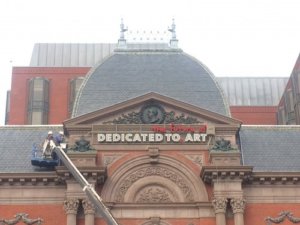 I’ve been wondering about the newly reopened Renwick Gallery here in Washington, DC. Long a cherished space, I was eager to see what the two year-long renovation of this Smithsonian museum—heretofore devoted to craft and decorative arts—had wrought. The first thing that jarred me was the bold white plastic sign along the exterior fence that announces “RENWICK” in giant sans-serif letters. In search of a photo, I came upon a number of articles that decried the placing of a garish LED sign on the front of the building, replacing the 1880s legend carved into the façade’s brownstone: “DEDICATED TO ART.” The new sign reads “DEDICATED TO THE FUTURE OF ART.” Museum officials say the sign is only temporary, part of the opening celebration. We can only hope. I’m also hoping the white plastic sign along the fence is temporary, but fear it’s not. The same logotype appears throughout the museum’s website and printed materials, no doubt in an attempt to shake off the lovely old building’s staid image. Strike one.
I’ve been wondering about the newly reopened Renwick Gallery here in Washington, DC. Long a cherished space, I was eager to see what the two year-long renovation of this Smithsonian museum—heretofore devoted to craft and decorative arts—had wrought. The first thing that jarred me was the bold white plastic sign along the exterior fence that announces “RENWICK” in giant sans-serif letters. In search of a photo, I came upon a number of articles that decried the placing of a garish LED sign on the front of the building, replacing the 1880s legend carved into the façade’s brownstone: “DEDICATED TO ART.” The new sign reads “DEDICATED TO THE FUTURE OF ART.” Museum officials say the sign is only temporary, part of the opening celebration. We can only hope. I’m also hoping the white plastic sign along the fence is temporary, but fear it’s not. The same logotype appears throughout the museum’s website and printed materials, no doubt in an attempt to shake off the lovely old building’s staid image. Strike one.
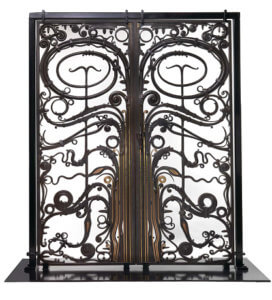
Portals, by Albert Paley, 1974
Strike two: the gorgeous 1974 Albert Paley portals are gone, replaced by anonymous brass doors that would be happy at a corporate headquarters or slick Neiman Marcus store. Could I somehow have missed the Paley gates? No…I found this image of the portals with the sad words, “No longer on view.”
Not a good start. Inside, the grand staircase is covered with a new red carpet that wends its way unevenly up to the second floor. This at least, is a stunning new addition, although the carpet has become noticeably soiled in the short time since the gallery’s opening earlier this month.
 The interior of the graceful old building is painted shades of chilly gray causing the elaborate moldings, cornices, and flourishes to withdraw in the face of the “future” of art, that bracing, challenging, whup upside the head that is the new direction of the Renwick.
The interior of the graceful old building is painted shades of chilly gray causing the elaborate moldings, cornices, and flourishes to withdraw in the face of the “future” of art, that bracing, challenging, whup upside the head that is the new direction of the Renwick.
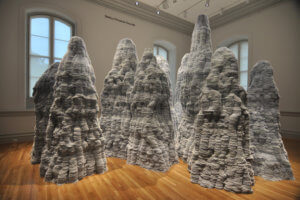
“Untitled,” 2014, by Tara Donovan
If the inaugural show—entitled “Wonder”—is an indication of what is to come—the future is overblown. “Wonder” gives us huge site-specific installations that occupy entire gallery spaces, an attempt at an ambitious foray into a new incarnation. As I walked through the galleries, though, I found myself longing for the delights of the permanent collection.
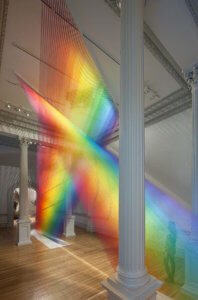
“Plexus A1,” 2015, by Gabriel Dawe
Tara Donovan’s “Untitled,” 2014, does have a spooky presence. Made of gazillions of styrene index cards, these sculptures appears to be about to lumber into motion, like a gaggle of Wookies waking up from a trance. I began to feel better.
The next gallery is inhabited by Gabriel Dawe’s “Plexus A1,” in which silken thread attached to a wooden base creates “fleeting rays of light” intended to evoke the Mexico City and East Texas skies of the artist’s youth.
Patrick Dougherty’s “Shindig” had museum-
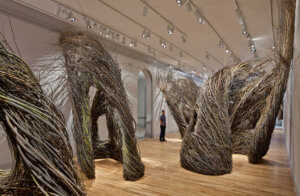
“Shindig,” 2015, by Patrick Dougherty
goers posing for pictures inside its winsome teepees of willow sticks. The piece, taking up the whole of the back gallery, looks as if a wind had blown through and deposited the structures. Like a swooping Maurice Sendak illustration, the forms whip and whirl and trail off into corners. Plus, they smell good—fresh and woodsy. I began to feel better still.

“1.8,” 2015, by Janet Echelman
But all my nascent good feelings were dashed in the former grand salon where Janet Echelman’s “1.8,” looms over an artist-designed carpet on the floor. Made of knotted and braided fiber with programmable lighting and wind movement, the piece is based on a map of the energy released across the Pacific Ocean during the 2011 Japanese earthquake and tsunami. This event shifted the earth on its axis and shortened the day by 1.8 millionth of a second. Large pillows on the floor allowed viewers to recline beneath the changing sculpture. “1.8” is monumental in size, but not awe-inspiring. It troubled me to see a natural cataclysm in which so many lives were lost reduced to a pretty macramé abstraction. I missed the old salon-style space, truth to tell.

“Volume, (Renwick),” 2015, by Leo Villareal
Leo Villareal’s “Volume” hangs over the grand staircase. Made of white LEDs, stainless steel, custom software, and electrical hardware, the shimmering, pulsing piece is set to sparkle in random patterns, never repeating a sequence. I enjoyed watching it, but was not as transported by it as I am by the same artist’s enveloping piece for the walkway between the East and West buildings of the National Gallery of Art.

“Folding the Chesapeake,” 2015, by Maya Lin
I adore Maya Lin’s work and had eagerly anticipated what she’d do for this show. “Folding the Chesapeake,” 2015, is made of industrial fiberglass balls glued to the floor and up the walls of the gallery space. The artist’s intent was “sharpening our focus on the need for conservation,” which I found a bit of a stretch. Still, this piece is lighter, more fluid, and while conceptual at base, more pleasing to the eye than many of the works created for this show.

“Seafoam and Amber-Tipped Chandelier,” 1994, by Dale Chihuly
I enjoyed Dale Chihuly’s “Seafoam and Amber-Tipped Chandelier,” glass, 1994, hanging over the classical nude in the octagon room. In it, I felt some small ghost of the original Renwick had survived. But really, it’s hung too high. You practically miss it.

“Middle Fork (Cascades),” 2015, by John Grade
Two works—one made of recycled tires by Chakaia Booker and John Grade’s enormous tree—left me puzzled. The tires didn’t speak to me at all and Grade’s meticulously reproduced 150-year-old hemlock made me wonder (pun intended) why he’d gone to all the trouble. First he cast the tree, and then recreated it out of small pieces of “reclaimed old growth Western cedar,” using hours and hours of volunteer manpower in the process. The piece seemed an over-wrought attempt at duplicating a phenomenon of nature. It didn’t work for me in much the same way as Janet Echelman’s tidal wave fell flat.
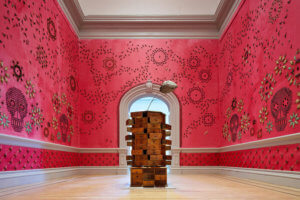 “In the Midnight Garden,” by Jennifer Angus is more than a little creepy. The artist has created stiff repeating floral wall patterns and day-of-the-dead skulls out of insects – yep, those are real bugs—and washed the walls with cochineal pink. In the center is an old chest of drawers, topped by a wasp’s nest and filled with curiosities: more bugs, buttons, feathers, tiny books, artificial fingernails. This Joseph Cornell-like piece smelled musty, like grandma’s attic, a pleasant, evocative scent that drew me in. I tried not to look too hard at the six-inch dead critters pinned to the walls.
“In the Midnight Garden,” by Jennifer Angus is more than a little creepy. The artist has created stiff repeating floral wall patterns and day-of-the-dead skulls out of insects – yep, those are real bugs—and washed the walls with cochineal pink. In the center is an old chest of drawers, topped by a wasp’s nest and filled with curiosities: more bugs, buttons, feathers, tiny books, artificial fingernails. This Joseph Cornell-like piece smelled musty, like grandma’s attic, a pleasant, evocative scent that drew me in. I tried not to look too hard at the six-inch dead critters pinned to the walls.
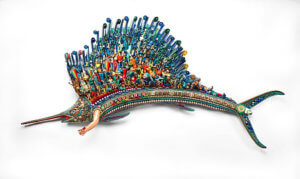
“Game Fish,” 1988, by Larry Fuente
Not even the gift shop was welcoming. It’s been recast as a sleek jewel box of a space with a lot fewer books and a lot more artfully draped 300 dollar scarves. I’d been longing for the icon of the Renwick’s permanent collection, Larry Fuente’s “Game Fish,” and found it, mounted in the gift shop above a display of game fish magnets and other tchotchkes. That about sums it up, folks: Take what made the Renwick great and make a fridge magnet out of it.
Sigh. I guess I’m no longer wondering. I’m mightily disappointed in the “new” Renwick. The only consolation is that, once “Wonder” comes down on May 8, 2016, the permanent collection will come back.
Please, please, please.
http://renwick.americanart.si.edu/




